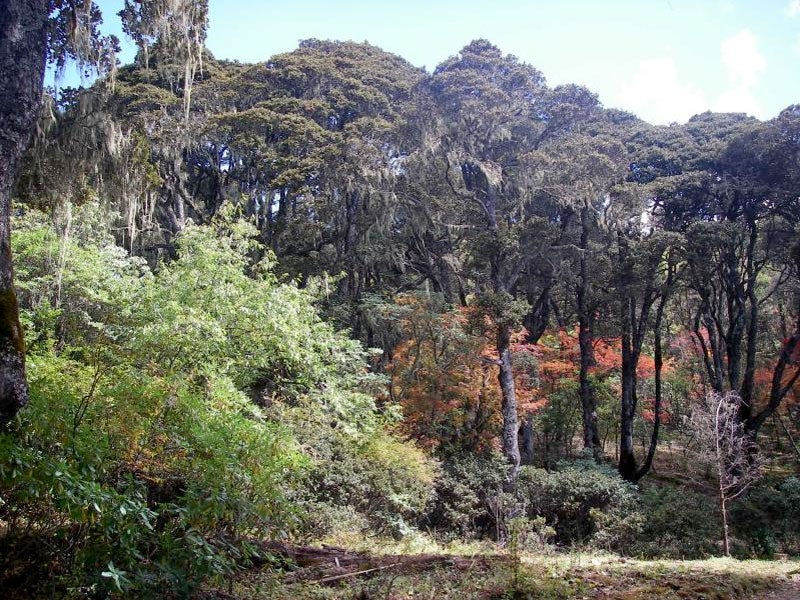The Project

The Himalayan temperate forest biome stretches across seven countries, and has among the highest rates of threatened and endemic species in the world. Deforestation rates vary widely among countries – from 1.7% in Myanmar, to 0.5% in Bhutan. Why this variation? Could national-level policy be driving these differences? Using rigorous statistical analysis and a trans-Himalayan deforestation dataset, we illuminated the drivers of Himalayan deforestation and measured how national-level policies impact forest conservation.
While much research delves into the effectiveness of protected areas to prevent deforestation, the majority of forests are not in protected areas. For example, in the Himalayan region, only 13% of forests are inside a protected area. Deforestation rates for unprotected forests vary widely among countries, but it is not well-understood what drives those differences. We hypothesized that a country’s national-level forest policies have a major influence on deforestation. This hypothesis, to our knowledge, had never been tested with empirical data.
In our new article out in Conservation Biology, we performed this analysis — we assessed the effectiveness of different national forest-management regimes to safeguard forests outside protected areas. We compared 2000-2014 deforestation rates across temperate forests of 5 countries in the Himalaya (Bhutan, Nepal, China, India, and Myanmar). The Himalayan countries are a fantastic natural experiment because countries differ in both overarching forest-management goals and specific tenure arrangements and policies for non-protected area forests. For example, China’s policies emphasize economic development while Bhutan’s promote “Gross National Happiness”, which is a balance between conservation, economic development, and cultural heritage. We used a trans-Himalayan dataset on deforestation and its drivers, and counterfactual analysis to measure differences in deforestation of unprotected forests between countries.
The Findings
We found three key results. First, we found that deforestation rates vary widely — up to 1.4% between countries — even when using counterfactual analysis to account for local determinants of deforestation, such as human population density, market access, and topography. Second, we found that the highest deforestation rates were associated with forest policies aimed at maximizing profits and unstable tenure regimes. Third, we found that the lowest deforestation rates were associated in countries whose policies emphasized conservation and community management.
We interpreted our results in the context of the broader literature on decentralized, community-based natural resource management. Our cross-national results are consistent with results from site- and regional-scale studies that show forest-management regimes that ensure stable land tenure and integrate local-livelihood benefits with forest conservation result in the best forest outcomes. Our findings emphasize that the type and quality of community-based forestry programs and the degree to which they are oriented toward sustainable use rather than economic development are important for forest protection.
The Team
Jodi Brandt, Boise State University
Contributors:
Teri Allendorf – University of Wisconsin
Volker Radeloff – University of Wisconsin
Jeremy Brooks – Ohio State University
The Products
Brandt, J. S., T. Allendorf, V. Radeloff, and J. Brooks. 2017. Effects of national-level forest management regimes on non-protected forests of the Himalaya. Conservation Biology.
Brandt, J. S., M. A. Haynes, T. Kuemmerle, D. M. Waller, and V. C. Radeloff. 2013. Regime shift on the roof of the world: Alpine meadows converting to shrublands in the southern Himalayas. Biological Conservation 158:116-127.
Brandt, J. S., E. M. Wood, A. M. Pidgeon, L.-X. Han, Z. Fang, and V. C. Radeloff. 2013. Sacred forests are keystone structures for forest bird conservation in southwest China’s Himalayan Mountains. Biological Conservation 166:34-42.
Brandt, J.S., and E. Bartee. (2012). “The Birds of Shangrila”. Yunnan Minorities Publishing. 266 pp. Interactive pdf: https://www.researchgate.net/publication/263271811_Birds_of_Shangrila
Wood, E. M., J. S. Brandt, A. M. Pidgeon, and V. C. Radeloff. 2015. Habitat-occupancy associations and tree-species use patterns by breeding birds in Tibetan sacred forests. Biodiversity and Conservation 24:129-148
Brandt, J. S., V. Butsic, B. Schwab, T. Kuemmerle, and V. C. Radeloff. 2015. The relative effectiveness of protected areas, a logging ban, and sacred areas for old-growth forest protection in southwest China. Biological Conservation 181:1-8.
Allendorf, T. D., J. S. Brandt, and J. M. Yang. 2014. Local perceptions of Tibetan village sacred forests in northwest Yunnan. Biological Conservation 169:303-310.